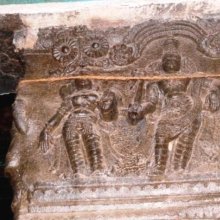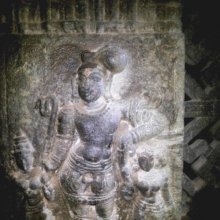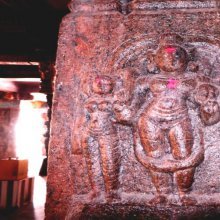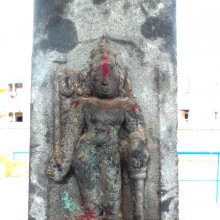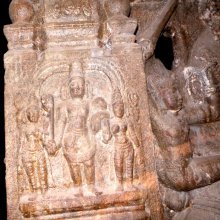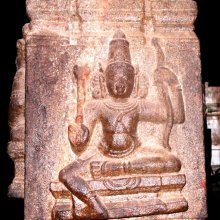Whip: 1 definition
Introduction:
Whip means something in the history of ancient India. If you want to know the exact meaning, history, etymology or English translation of this term then check out the descriptions on this page. Add your comment or reference to a book if you want to contribute to this summary article.
Images (photo gallery)
(+4 more images available)
India history and geography
Source: Singhi Jain Series: Ratnaprabha-suri’s Kuvalayamala-katha (history)Whips (having sharp points) (used for pricking bullocks) represents a scene of human life commonly depicted on the Saṃsāracakra paintings in ancient India, as mentioned in the Kathās (narrative poems) such as Uddyotanasūri in his 8th-century Kuvalayamālā (a Prakrit Campū, similar to Kāvya poetry).—Page 185.21 f.: Here follows a description of a printed scroll illustrating the Jaina conception of saṃsāracakra. [...] The saṃsāra-cakra illustrated the three worlds of hell, human world and the world of gods. [For example:] the agriculturists engaged in ploughing their field with plough, bullocks with pierced nostrils and with ropes tied round their necks, having ploughs on their necks, and bleeding owing to their having been pricked with sharp pointed whips.

The history of India traces the identification of countries, villages, towns and other regions of India, as well as mythology, zoology, royal dynasties, rulers, tribes, local festivities and traditions and regional languages. Ancient India enjoyed religious freedom and encourages the path of Dharma, a concept common to Buddhism, Hinduism, and Jainism.
See also (Relevant definitions)
Starts with: Whip grass, Whip plant, Whip vine, Whipstick canthium.
Ends with: Coach-whip, Devils whip.
Full-text (+267): Kasa, Pratoda, Kashaghata, Carmadanda, Carmayashti, Cavhariyaasuda, Cavhara, Sacetaka, Tapatanem, Madhukasha, Tutati, Carmanasika, Asoda, Cabuka, Atikasha, Tadana, Pratishkasa, Ashvajani, Coda, Korade.
Relevant text
Search found 100 books and stories containing Whip; (plurals include: Whips). You can also click to the full overview containing English textual excerpts. Below are direct links for the most relevant articles:
Defections and Parliamentary Democracy < [January 1970]
The Authority < [April – June 1992]
Any Enquiries? < [April – June, July – September 1978]
Kathasaritsagara (the Ocean of Story) (by Somadeva)
Note on the story of Vāmadatta < [Notes]
Note on the “magic obstacles” motif < [Notes]
The “forbidden chamber” motif < [Notes]
Kautilya Arthashastra (by R. Shamasastry)
Chapter 3 - The Duty of a Wife < [Book 3 - Concerning Law]
Chapter 5 - Detection of Youths of Criminal Tendency by Ascetic Spies < [Book 4 - Removal of Thorns]
Chapter 32 - The Training of Elephants < [Book 2 - The duties of Government Superintendents]
Trishashti Shalaka Purusha Caritra (by Helen M. Johnson)
Part 3: Meeting of Rāma and his sons < [Chapter IX - Sītā’s purification and taking of the vow]
Part 8: Story of the Nāga and Nāgiṇī < [Chapter I - Brahmadattacaritra]
Part 9: His horse carries him into the forest < [Chapter VII - Sanatkumāracakricaritra]
The Tattvasangraha [with commentary] (by Ganganatha Jha)
Verse 2531-2532 < [Chapter 24b - Arguments against the reliability of the Veda (the Revealed Word)]
The Brahmanda Purana (by G.V. Tagare)
Chapter 29 - A quarrel over the Cow: Jamadagni murdered < [Section 3 - Upodghāta-pāda]
Chapter 1 - Birth of seven sages (saptarṣi): Race of Bhṛgu and Aṅgiras < [Section 3 - Upodghāta-pāda]
Related products
